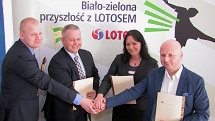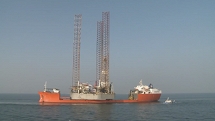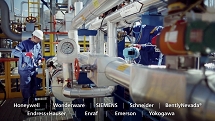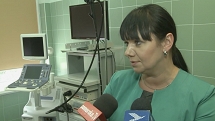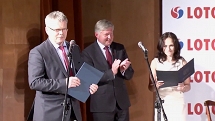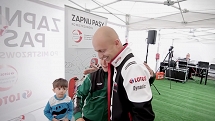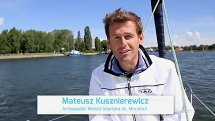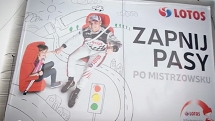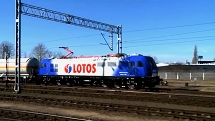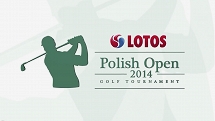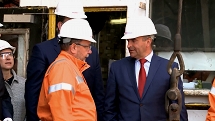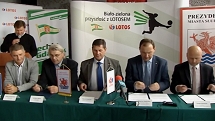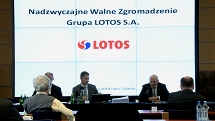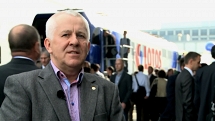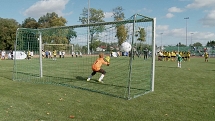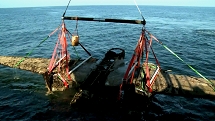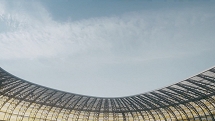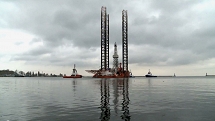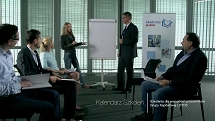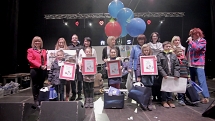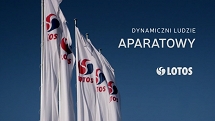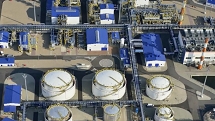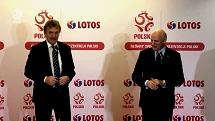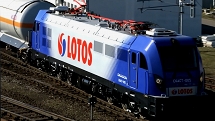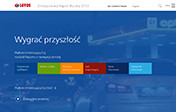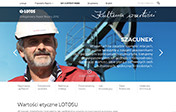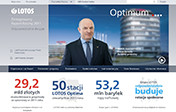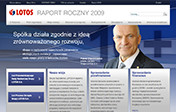-
Financial information
The past year ushered in a series of challenges for the companies in the fuel sector. The decisions made by us have demonstrated that we are able to take rapid steps to adapt to a demanding environment and ensure the desired profitability for our projects.
-
Segment performance
The segmental management model we have implemented enhances management efficiency, delivering cost and revenue synergies across the organization.
-
Letter from the Vice-President of the Board
2014 ushered in a series of challenges for the companies in the fuel sector. The decisions made by the LOTOS Group have demonstrated that we are able to take rapid steps to adapt to a demanding environment and ensure the desired profitability for our projects.
-
Business environment
The key factor that had a strong impact on both the global and Polish petroleum markets in 2014, with significant consequences for the LOTOS Group’s performance, was the price of crude oil, which also determined the price of petroleum products.
-
Strategic objectives
The LOTOS Group’s Strategy is designed to strengthen our position as a strong, innovative and efficient business which plays a major role in ensuring national energy security.
-
Business model
Our operations consist in crude oil production and processing, as well as wholesale and retail sale of petroleum products, among which are: fuels (unleaded gasoline, diesel oil and light fuel oil), heavy fuel oil, bitumens, aviation fuel, naphtha, propane-butane LPG and base oils.
-
Risk and opportunities
At the LOTOS Group, we identify a range of diverse risks, which may affect all areas of our business. The key risks in terms of their impact on our operations are the financial risks as well as risks affecting the exploration and production area. In the analysis of the risks, we also factor in issues related to sustainable development.
-
Key data 2014
With revenue of ca. PLN 28.5bn in 2014, we rank fourth in the group of 500 largest businesses in Poland.

Environmental impact
The business activity of the LOTOS Group involves significant environmental impacts, through emissions of pollutants into the air, generation of waste, use of water and discharge of effluent to waterways or into the ground. The scale and nature of our environmental impacts are regulated under the environmental protection laws. In connection with their activities, companies of the LOTOS Group hold a number of permits, including integrated permits, which regulate the operational and environmental aspects of the LOTOS Group installations.
We have taken a strategic approach to minimising our environmental impacts, which is why the Grupa LOTOS refinery, our major plant, is now one of the most environmentally friendly refineries in the territory of the European Union, Switzerland and Norway. The switchover to natural gas as the key fuel for the Grupa LOTOS refinery in 2012, accompanied by other investments reducing energy consumption, such as the construction of a flare gas recovery unit and installation of new furnaces in the gasoline and lubricating oil units, reduced the sulfur and dust emissions from the CHP plant down to almost zero and brought the carbon emissions to levels seen only at the best European refineries. The refinery’s advanced environmental solutions have curbed our environmental impacts while delivering notable financial benefits, in the form of lower fees for the use of the environment, resulting from our commitment to reducing the amount of emitted pollutants.
Gas emissions are the most critical source of environmental nuisance caused by our plants, both for their immediate environment and areas located further away. Therefore, we are increasingly concerned to ensure that the processes involving greenhouse gas emissions are based on the best available technologies and practices reducing the amount of emissions.
2014 was another demanding period for the EU Emissions Trading Scheme (EU ETS) and its participants. The European Commission commenced legislative work to introduce a permanent mechanism balancing the demand for and supply of emission allowances, which would result in structural changes of the EU ETS. The discussions and negotiations related to the proposed reform of the EU ETS commenced in autumn 2014 and are continued in 2015. A temporary solution consisting in postponing the auctioning of a part of CO2 allowances to stimulate an increase in their price (back-loading) was agreed in February 2014. The first auction with allowance volumes reduced as part of the back-loading mechanism was held in March last year. The back-loading and the European Commission’s legislative work on the proposed reform led to an increase in the prices of EUA in 2014. What it means to the EU ETS participants is that if they do not take steps and make investments to reduce the amount of emissions from their installations, they will have to incur the costs of offsetting the emissions with a higher price of CO2 allowances. (See more)
As in previous years, the only greenhouse gas generated by Grupa LOTOS was carbon dioxide emitted in the process of burning fuel in furnaces and boilers, steam cracking of light hydrocarbons in hydrogen plants and burning of hydrocarbons in flare stacks.
The emission amounts are assessed on the basis of measurements of burnt fuels, feedstocks or flared hydrocarbons, and the corresponding emission rates calculated on the basis of laboratory analyses or reference values.
The emissions reported by Grupa LOTOS for 2014 are significantly higher than those for 2013, which is attributable to a month-long maintenance shutdown in the first half of 2013.
Type of CO₂ emissions in Grupa LOTOS [thousand tonnes per year]
| Type of emission | 2012 | 2013 | 2014 |
|---|---|---|---|
| Direct | 1,979 | 1,689 | 1,820 |
| Indirect | 400 | 373 | 411 |
| Total | 2,379 | 2,062 | 2,231 |
The only source of indirect emissions in Grupa LOTOS is the purchase and use of electricity.
Greenhouse gases emitted by the LOTOS Petrobaltic offshore rigs are produced in the process of burning diesel oil and other fuels in power systems, steam boilers and crane engines. All gas produced on the ‘Petrobaltic’ rig is burned in flare stacks, which are designed to minimise the emissions of harmful substances. All of its CO2 emissions come from the combustion of natural gas and fuel oil in the generation of electricity and heat. Natural gas extracted from under the Baltic Sea bed does not contain any chemical compounds or substances the combustion of which could produce emissions of any greenhouse gases other than CO2. The methane which is a component of fuel gas is burnt up and is not emitted into the atmosphere. Other products of gas separation do not contain greenhouse gases and do not produce emissions of any gases other than CO2 when used by end users.
Emissions of gases produced in the course of exploration and production operations are not regulated under the Polish or international law, and so are not monitored.
| CO2 emissions in 2014 [tonnes] | Amount |
|---|---|
| LOTOS Petrobaltic - excluding offshore activities* | 1,076 |
| Energobaltic (CHP plant in Władysławowo) | 12,747 |
* Operations in the Polish Economic Zone are not subject to reporting to the National Centre for Emissions Balancing and Management (KOBiZE).
2014 was one more year in which we did not use any ozone-depleting substances. The only substance with such properties is Halon 1302 in the fixed fire extinguishing system on the LOTOS Petrobaltic rig. There, Halon is kept in sealed bottles and was not released in 2014. Its import and use have been authorised under a licence granted by the European Commission. Use of this type of Halon is permitted in installations such as the one on the LOTOS Petrobaltic rig until 2020.
In 2014, we did not offer for sale any products which, when put to use, would produce or emit any ozone-depleting compounds, neither do we offer such products now.
2014 saw a continued effort to maximise the switchover from heavy fuel oil to fuel gas and natural gas in our refinery and the CHP plant in Gdańsk. Natural gas was still used as feedstock in the production of hydrogen. Further reduction of CO2 emissions from Grupa LOTOS installations was made possible as a result of upgrading the fourth, and thus the last, boiler at the CHP plant. All the CHP plant boilers are now finally adapted to burning natural gas.
As a result of these investments, the emission intensity of our installations, expressed in kg CO2/CWT, dropped to 30.0 from 30.4 in 2013. It is worth noting here that in 2014 we came even closer to the European benchmark of 29.5 kg CO2/CWT, attained by only 10% of Europe’s least emission-intensive refineries.(See more)
Under the integrated permit, Grupa LOTOS is required to monitor its emissions of sulfur dioxide (SO2), nitrogen oxides (NOx), and particulate matter (PM). The permit specifies the maximum permissible emissions separately for the CHP plant and the refinery in Gdańsk.
In compliance with the legal requirements applicable to this type of installations, the CHP plant features a continuous measurement system, for ongoing monitoring of pollutant concentration in exhaust gases to estimate the amount of emissions into the air.
The legal requirements applicable to the refinery are less strict. There, emissions are measured from each process emitter twice a year, during the heating and non-heating season, by a specialist company.
Despite the maintenance shutdown in 2013, 2014 saw a drop in sulfur dioxide emissions. It was possible thanks to the fact that in July 2014 we ceased burning heavy fuel oil at the CHP plant, while its use in the refinery was reduced to a minimum. Natural gas became the main fuel for the CHP plant, and fuel gas − for the refinery.
Pollutant emissions in Grupa LOTOS [tonnes per year]:
| Substance | 2012 Es | 2012 Ed | 2013 Es | 2013 Ed | 2014 Es | 2014 Ed |
|---|---|---|---|---|---|---|
| SO2 | 3,370 | 6,342 | 548 | 5,169 | 313 |
5,169 |
| NOx | 1,308 | 2,501 | 843 | 2,264 | 927 |
2,264 |
| PM | 264 | 461 | 91 | 366 | 96 |
366 |
Es - actual level of emissions from Grupa LOTOS installations
Ed - permissible level of emissions
Pollutants emitted from the LOTOS Petrobaltic Group installations are produced in the process of burning fuels.
Pollutant emissions in the LOTOS Petrobaltic Group* [tonnes per year]
| Substance | 2012 | 2013 | 2014 |
|---|---|---|---|
| LOTOS Petrobaltic | |||
| SO2 | 0.007** | 4.53 | 527.47 |
| NOx | 0.30** | 26.88 | 2,458.70 |
| Dust | - | 2.88 | 452.16 |
| LOTOS Geonafta | |||
| SO2 | 0.40 | 0.46 | 0.39 |
| NOx | 4.00 | 2.95 | 2.50 |
| VOC (volatile organic compounds) | 100.00 | 69.54 | 68.84 |
| Dust | 3.00 | 0.29 | 0.24 |
| Energobaltic | |||
| SO2 | 0.10 | 0.004 | 0.013 |
| NOx | 11.90 | 11.23 | 12.20 |
| Dust | 0.20 | 0.005 | 0.11 |
* LOTOS Norge did not conduct any operational activities.
** Emissions excluding offshore activities.
In 2014, members of the local community who watch the flare stacks of our refinery in Gdańsk could see a regular flame at the top only occasionally. A series of minor investment projects and enhancements implemented during the maintenance shutdown, combined with the launch of a flare gas recovery unit in 2013, allowed us to significantly decrease the amount of flare gas.
Amount of discharge – amount of flare gas in Grupa LOTOS [thousand cubic metres per year]
| Source | 2012 | 2013 | 2014 |
|---|---|---|---|
| Flare stack 3500 | 19,388 | 16,363 | 5,594 |
| Flare stack 3550 | 3,603 | 5,499 | 4,069 |
| Total | 22,991 | 21,862 | 9,663 |
In July 2014, we carried out optimisation work in the refinery’s Hydrocracking Unit, which resulted in shutting down one of its three process furnaces. It has enabled us to use process heat in the hydrocracking process rather than energy generated by burning fuels. On the basis of available process data, we estimate that fuel consumption at this installation has dropped by ca. 10%.
Thanks to some new measurement points placed throughout the refinery, corrective measures were taken in spots with high consumption of workshop air. As a result, the refinery’s requirement for this medium dropped by ca. 50% (900 Nm3/h) within a short period of time. We also managed to permanently reduce the amount of active electric power consumed by the compressors by 126 KW.
In 2014, we developed and implemented energy efficiency guidelines for the planning of all investment activities. The document entitled ‘Energy criteria applicable to projects, repair works and procurement of products and services at Grupa LOTOS’ was incorporated into the Integrated Management System.
Direct energy consumption of Grupa LOTOS in 2014, by primary energy source [GJ]
| Item | Direct, purchased energy | Direct, produced energy | Direct, soldenergy |
Direct, totalenergy consumption |
|---|---|---|---|---|
| Natural gas | 9,606,628 |
9,606,628 |
||
| Fuel gas | 10,761,377 |
141,164 |
10,620,213 |
|
| Residual gas | 3,527,961 |
3,527,961 |
||
| HSFO+Bleed fuel oil | 0 |
0 |
||
| LSFO | 0 |
885,398 |
885,398 |
|
| Light fuel gas (HON) | 2,931 |
2,931 |
||
| Electricity | 0 |
0 |
||
| Heat | 106,290* |
- 106,290 |
||
| Total | 9,606,628 |
15,177,667 |
247,454 |
24,536,841 |
* - 106,290 GJ represents primary energy consumed to produce sold heat (usable forms of energy) in the amount of 89,103 GJ.
| Indirect energy consumption of Grupa LOTOS, by primary energy source - energy purchased from the National Power Grid [GJ] | 2012 | 2013 | 2014 |
|---|---|---|---|
| 4,407,590 | 4,036,944 | 4,342,487 |
| Electricity purchased | MWh | 491,666 |
|---|---|---|
| GJ | 1,769,998 |
|
| Primary energy used for production of purchased electricity (indirect) | GJ | 4,342,487 |
Gas separated from the formation fluid on the production platform is pumped via a gas pipeline to the Energobaltic gas power station, where it is converted into energy.
The main source of energy used on drilling platforms is diesel oil, delivered by supply vessels. Production platforms also use natural gas, extracted together with oil. On drilling platforms, energy is generated by a system of engines and generators running on diesel oil, which meets the legal requirement of less than 1% sulfur content, applicable since January 2015.
The generated energy is distributed across the platform by means of power equipment. On the Baltic Beta platform, energy is additionally generated by gas turbines running on gas separated from the formation fluid, composed chiefly of crude oil. The energy turbine powers the entire Baltic Beta platform and the PG-1 wellhead platform, while the other turbine drives a pump injecting water into the reservoir. LOTOS Petrobaltic’s offshore units were powered by fuel containing 0.1% of sulfur as early as in 2014. In LOTOS Geonafta, energy on the rigs is produced by a diesel generator.
Direct energy consumption of LOTOS Petrobaltic in 2014, by primary energy source [GJ]
| Item | Direct – purchased energy | Direct – produced energy | Direct – sold energy |
Direct – total energy consumption |
|---|---|---|---|---|
| Natural gas | 5,023 |
941,873 |
663,615 |
283,281 |
| Diesel oil | 153 |
0 |
0 |
153 |
| Total | 5,176 |
941,873 |
663,615 |
283,434 |
Direct energy consumption of LOTOS Geonafta in 2014, by primary energy source [GJ]
| Item | Direct – purchased energy | Direct – produced energy | Direct – sold energy |
Direct – total energy consumption |
|---|---|---|---|---|
| Natural gas | 2,559 |
0 |
0 |
2,559 |
| Fuel gas | 0 |
17,606 |
0 |
17,606 |
| Diesel oil | 20,987 |
0 |
0 |
20,987 |
| Total | 23,546 |
17,606 |
0 |
41,152 |
In Energobaltic, gas is used to generate heat in heating boilers. Natural fuel gas is obtained in the process of separation of waste natural gas. This fuel is used for co-generation of heat and electricity, as well as for heat generation in boilers. The medium which carries the heat transferred, for a payment, to end users of the municipal heating network in Władysławowo, is hot water.
Direct energy consumption of Energobaltic in 2014, by primary energy source (GJ)
| Item | Direct - purchased energy | Direct - produced energy | Direct - sold energy | Direct - total energy consumption |
|---|---|---|---|---|
| Natural gas type E (GZ 50) | 10,353 |
0 |
0 |
10,353 |
| Natural fuel gas (dry) | 0 |
297 538 |
0 |
297,538 |
| Light fuel oil | 357 |
0 |
0 |
357 |
| Electricity | 0 |
62,215 |
59,582 |
2,633 |
| Heat | 0 |
131,888 |
103,055 |
28,833 |
| Total | 10,710 |
491,641 |
162,637 |
339,714 |
Indirect energy consumption of the LOTOS Petrobaltic Group, by primary energy source [GJ]
| 2012 | 2013 | 2014 | |
|---|---|---|---|
| LOTOS Petrobaltic | |||
| Energy purchased for the land base’s operations | 6,398 | 5,948 | 6,085 |
| LOTOS Geonafta | |||
| Energy purchased for administrative purposes | 4,465 | 1,256 | 1,224 |
| Energy for production purposes | 12,071 | 11,826 | 13,493 |
| Total | 16,536 | 13,082 | 14,717 |
| Energobaltic | |||
| Electricity purchased | 25,776 | 26,539 | 29,165 |
Materials used
The main raw materials used in exploration and production drilling include drilling mud components and cement used to bind casing to the drilled rock. LOTOS Petrobaltic does not use oil-based muds for drilling, and relies only on water-based muds.
The main raw materials used in the production process also include chemical substances added to the formation and produced water pumping system and materials used as filter inserts. Formation water is saturated brine, mostly chlorine, sodium and calcium brine.
In order to protect the Baltic Sea, LOTOS Petrobaltic re-injects produced water back into the field. This solution does not interfere with the marine environment or with the field formation. The Baltic Sea is particularly sensitive, which is why operations on the Baltic Sea are governed by rigorous regulations. Consequently, the parameters of water around the platforms have to be continually monitored to ensure that they meet the relevant environmental requirements.
Raw materials and consumables used by the LOTOS Petrobaltic Group, by weight and volume
| LOTOS Petrobaltic | |||
|---|---|---|---|
| Injected and formation water | 2012 [tonnes] |
2013 [tonnes] |
2014 [tonnes] |
| Biocides | 8.90 | 10.17 | 5.57 |
| Coagulants | 2.11 | 1.69 | 2.60 |
| De-emulsifiers | 6.55 | 8.84 | 5.23 |
| Other | 2.35 | 15.16 | 48.41 |
| Total | 19.91 | 35.90 | 61.81 |
| Drilling mud | |||
| Bentonite | 4.66 | 19.3 | 3.50 |
| Salts (drilling mud and packer fluid) | 54.39 | 78.8 | 55.00 |
| Hydroxides | 3.09 | 2.9 | 2.60 |
| Other (for maintaining appropriate properties - viscosity, filtration, etc.) | 18.17 | 22.8 | 34.39 |
| Total | 80.31 | 123.80 | 95.49 |
| Cement slurry | |||
| Cement | 217.45 | 430.6 | 224.16 |
| Processing agents | 1.84 | 14.4 | 29.97 |
| Total | 219.29 | 445.0 | 254.13 |
| Total use | 319.51 | 604.7 | 411.43 |
| Substances used in the transport of gas from platform through pipeline to Władysławowo | |||
| Methanol | 5.66 | 8.08 | 9.18 |
| LOTOS Geonafta | |||
| Substances used in the drilling process |
2012
[tonnes]
|
2013
[tonnes]
|
2014
[tonnes]
|
| Acid inhibitors | 3.83 | 6.95 | 3.66 |
| Drilling mud additives | 60.03 | 111.40 | 136.34 |
| Polymers | 30.56 | 48.31 | 57.65 |
| Blockers | 54.95 | 29.25 | 48.80 |
| Lubricants | 2.03 | 1.40 | 1.20 |
| Cement | 62.02 | 162.42 | 200.12 |
| Extraction additives | 25.21 | 111.40 | - |
| Total | 238.63 | 471.13 | 447.77 |
| Substances used in the production process | |||
| Corrosion inhibitors | 0.88 | 2.16 | 1.71 |
| De-emulsifiers | 23.42 | 29.28 | 25.11 |
| Oxidants | 0.60 | 0.20 | 0.20 |
| Total | 24.90 | 31.65 | 27.02 |
| Total use | 263.53 | 502.78 | 474.78 |
| Energobaltic | |||
| Stage I - Gas Compressor Station | 2012 | 2013 | 2014 |
| Input material: waste gas [Nm3] |
10,350,433 | 9,790,352 | 10,884,082 |
| Indirect production material: methanol [l] |
11,400 | 10,200 | 11,600 |
| Stage II - Gas/Input Material Separator Station | |||
| Input material: waste natural gas (wet) for LPG production [tonnes] |
5,332.4 | 4,966.58 | 5,474 |
| Input material: natural gas condensate | 1,550.5 | 1,613.51 | 1,719 |
| Obtained natural fuel gas (dry) as a fuel for heat and electricity generation [Nm3] |
5,572,326 | 5,250,374 | 5,950,766 |
Raw materials and consumables used by Grupa LOTOS, by weight and volume [tonnes]
| Raw materials | 2012 | 2013 | 2014 |
|---|---|---|---|
| Crude oil | 9,673,647 | 8,702,622 | 9,545,307 |
| Raw materials and components | 833,610 | 834,114 | 909,379 |
| Enhancing additives | 2,091 | 1,994 | 1,980 |
Water consumption
The refinery in Gdańsk draws process water into a retention tank with a capacity of 350,000 m3, constructed in the Motława oxbow lake. Underground water is sourced from Cretaceous and Quaternary formations. Cretaceous water is an important source of water for human use. Because of its quality, Quaternary water is used solely for industrial purposes and not classified as a material source of water.
The economic use of water resources is based on relevant water use and integrated permits. Analyses of the environmental impact of our water abstraction confirm that it does not affect any protected sites or areas of great environmental value, and that the amount of water abstracted is substantially below permitted volumes.
Total freshwater abstracted by Grupa LOTOS, by source [m3/year]
| Source | 2012 | 2013 | 2014 |
|---|---|---|---|
| Underground water | 189,217 | 162,511 | 156,161 |
| Surface water | 3,532,113 | 3,574,791 | 3,454,532 |
| Total | 3,721,330 | 3,737,302 | 3,610,693 |
Grupa LOTOS processes consuming large quantities of water
| 2012 | 2013 | 2014 | |
|---|---|---|---|
| CHP plant - utilities production | 2,936,080 | 2,778,592 | 3,053,329 |
| Refinery – circulatory cooling water | 1,503,995 | 1,418,925 | 1,444,183 |
None of the companies of the LOTOS Petrobaltic Group are depleting water resources through excessive abstraction.
In the production process, formation fluid is withdrawn from the reservoir, and subsequently separated into crude oil, natural gas and formation water. Before the water injection system was installed on the Baltic Beta platform, formation water had been purified of oil components to a level below 15 ppm (parts per million) and discharged into the sea. At the same time, an appropriate amount of sea water was pumped into the reservoir to maintain pressure. At present, in line with the environmental requirements set forth in the Baltic Sea Action Plan, we do not discharge oily formation water into the sea, but pump it back into the reservoir in place of sea water. Since the volume of formation water does not suffice to maintain reservoir pressure, we continue to use sea water, too.
Total freshwater abstracted by LOTOS Petrobaltic, by source
| Source | Amount of water abstracted [m3] | ||
|---|---|---|---|
| 2012 | 2013 | 2014 | |
| Freshwater – own intake | 19,988 | 27,645 | 32,631 |
| Freshwater – municipal water supply | 1,392 | 2,467 | 4,127 |
| Seawater | 311,972 | 303,121 | 411,188 |
| Formation water | 75,712 | 94,366 | 166,752 |
| Total | 409,064 | 427,599 | 614,814 |
Total freshwater abstracted by LOTOS Geonafta, by source
| Source | Amount of water abstracted [m³] | ||
|---|---|---|---|
| 2012 | 2013 | 2014 | |
| Freshwater | 2,553 | 3,012 | 3,335 |
| Water for process purposes | 1,146 | 1,855 | 2,968 |
| Total | 3,699 | 4,867 | 6,303 |
Total freshwater abstracted by Energobaltic, by source
| Source | Amount of water abstracted [m³] | ||
|---|---|---|---|
| 2012 | 2013 | 2014 | |
| Water from municipal network | 5,538 | 4,853 | 4,755 |
Our goal is to continue to reduce the amount of water abstracted from the environment, for instance by increasing the consumption of recycled water. In 2014, the share of water recycled by Grupa LOTOS under its water and wastewater management system was high, as in previous years.
Volume of water recycled in Grupa LOTOS [m3]
| 2012 | 2013 | 2014 | |
|---|---|---|---|
| Industrial water produced from treated wastewater | 1,254,556 | 1,368,844 | 1,374,123 |
| Pure condensate volume | 2,207,217 | 2,237,300 | 2,412,540 |
Total volume of water recycled in Grupa LOTOS
| Unit | 2012 | 2013 | 2014 | |
|---|---|---|---|---|
| Total volume of recycled water | m3 | 3,461,773 | 3,606,144 | 3,786,663 |
| Percentage of recycled water | % | 48.2 | 49.1 | 51.2 |
Treated wastewater from Grupa LOTOS is discharged to the Martwa Wisła river (process wastewater, oil-containing water and sanitary waste) and Rozwójka river (drainage water and rainwater). The Martwa Wisła waters in the refinery area are classified as internal seawaters, whereas the Rozwójka river is an element of the Żuławy Gdańskie hydrological improvement system and a tributary of the Martwa Wisła.
In 2014, there were no changes in the environmental classification of our receiving waters. Neither of them is protected or has high biodiversity value in the discharge area. Moreover, the long-term monitoring has confirmed that wastewater discharged by Grupa LOTOS has no material impact on them. Additionally, the operation of the refinery does not seem to negatively affect any of the habitats located in the vicinity of its discharge areas. On the contrary, a sort of natural balance has been achieved.
The separate treatment lines allow us to redirect almost the entire volume of treated oily rainwater to produce industrial water, which is fed back to the plant and reused. Only excess volumes of treated oily rainwater are discharged, together with technical and sanitary wastewater, to the receiving body.
For years, Grupa LOTOS has maintained a high quality of treated wastewater, with most indicators below 50% of the maximum levels defined in our permit.
Total volume of wastewater from Grupa LOTOS, by quality and destination [m3]
| 2012 | 2013 | 2014 | |
|---|---|---|---|
| Rozwójka | 4,305,910 | 4,220,723 | 3,684,925 |
| Martwa Wisła | 1,293,596 | 1,273,851 | 1,198,759 |
| Total | 5,599,506 | 5,494,574 | 4,883,684 |
Treated wastewater discharged by Grupa LOTOS into the Martwa Wisła river
| Indicator | Unit | 2012 Wr | 2013 Wr | 2014 Wr | 2012-2014 Wd |
|---|---|---|---|---|---|
| pH | - | 7.79 | 7.56 | 7.49 | 6.50-9.00 |
| Biological Oxygen Demand | mg O2/dm3 | 2.56 | 2.99 | 3.68 | 25.00 |
| COD | mg O2/dm3 | 30.20 | 44.10 | 60.0 | 125.00 |
| Total suspended solids | mg/dm3 | 6.38 | 7.89 | 6.61 | 35.00 |
| Volatile phenols | mg/dm3 | <0.005* | <0.005* | <0.005* | 0.10 |
| Petroleum ether extractables | mg/dm3 | 0.74 | 0.73 | 1.64 | 50.00 |
| Petroleum hydrocarbons | mg/dm3 | 1.93 | 0.23 | 0.08 | 5.00 |
| Total Nitrogen | mg/dm3 | 2.40 | 4.30 | 5.10 | 30.00 |
| Total Phosphorus | mg/dm3 | 1.03 | 0.57 | 0.69 | 3.00 |
| Sulfides | mg/dm3 | 0.006 | 0.009 | 0.008 | 0.200 |
| Nickel | mg/dm3 | 0.0102 | 0.0175 | 0.0033 | 0.5000 |
| Vanadium | mg/dm3 | 0.0289 | 0.0191 | 0.0037 | 2.000 |
| Aluminium | mg/dm3 | 0.0624 | 0.0690 | 0.0588 | 3.000 |
Treated wastewater discharged by Grupa LOTOS into the Rozwójka river
| Indicator | Unit | 2012 Wr | 2013 Wr | 2014 Wr | 2012-2014 Wd |
|---|---|---|---|---|---|
| Total suspended solids | mg/dm3 | 10.71 | 9.50 | 7.12 | 35.00 |
| Petroleum hydrocarbons | mg/dm3 | 2.15 | 0.74 | 0.20 | 5.00 |
Wr- actual average annual level
Wd - permissible average annual level
* result below the quantification limit in the analytical method used in a given year
On LOTOS Petrobaltic rigs, only treated wastewater and cooling water is discharged into the sea, with the condition of sea water around the platform monitored on a daily basis. Similarly, no wastewater produced by LOTOS Geonafta in its drilling operations is discharged directly into natural bodies of water. All process wastewater and greywater/blackwater is stored and subsequently transported to a wastewater treatment plant.
Volume of wastewater from the LOTOS Petrobaltic Group, by destination [m³]
| 2012 | 2013 | 2014 | |
|---|---|---|---|
| LOTOS Petrobaltic | |||
| Greywater/blackwater | 7,365 | 7,546 | 13,497 |
| LOTOS Geonafta | |||
| Greywater/blackwater | 2,553 | 3,012 | 2,842 |
| Energobaltic | |||
| Greywater/blackwater | 1,231 | 617 | 958 |
All formation water produced by LOTOS Petrobaltic in the oil extraction process is pumped back into the reservoir, whereas in LOTOS Geonafta formation water is stored on the rig and then transferred for disposal.
Volume and disposal method of formation water and water produced in the oil extraction process [m3]
| 2012 | 2013 | 2014 | |
|---|---|---|---|
| LOTOS Petrobaltic | |||
| Water injected back into the reservoir | 47,227 | 94,366 | 165,634 |
| LOTOS Geonafta | |||
| Formation water | 180 | 246,333 | 255,081 |
Waste management
Grupa LOTOS complies with all national and EU regulations and decisions, making every effort to manage its waste in an environmentally safe manner.
In 2014, there was an increase in the amount of hazardous waste generated by the Company, and a decrease in non-hazardous waste volumes. The ongoing efforts to increase the depth of oil conversion and regular cleaning of tanks at the wastewater treatment plant have resulted in higher amounts of hazardous waste generated. The year-on-year difference in non-hazardous waste volumes was attributable to the completion of maintenance work at the refinery.
Waste generated by Grupa LOTOS - quantity [tonnes/year]
| Waste generated by Grupa LOTOS | 2012 | 2013 | 2014 |
|---|---|---|---|
| Waste stored at the end of the previous year | 2,195 | 1,777 | 1,409 |
| Hazardous waste generated | 6,784 | 6,478 | 8,282 |
| Non-hazardous waste generated | 5,574 | 6,659 | 5,886 |
| Total waste generated | 12,358 | 13,137 | 14,168 |
| Volumes permitted by the integrated permit | 89,627 | 89,627 | 89,627 |
| Waste generated by contractors | 4,154 | 3,170 | 1,512 |
Waste management methods applied by Grupa LOTOS - quantity [tonnes/year]
| Waste management method | 2012 | 2013 | 2014 |
|---|---|---|---|
| Waste recycled | 12,749 | 13,504 | 14,342 |
| Waste treated or disposed of | 28 | 0 | 0.14 |
| Incineration | 27 | 0 | 0 |
| Landfilling | 1 | 0 | 0.14 |
| Waste stored on site at the end of the year | 1,777 | 1,410 | 1,235 |
| Hazardous | 1,503 | 1,376 | 1,224 |
| Non-hazardous | 274 | 34 | 11 |
The only hazardous waste sent abroad by Grupa LOTOS are spent catalysts. In 2014, the share of hazardous waste shipped internationally remained relatively unchanged. Spent catalysts were transferred to a specialist company for recycling.
| Type of hazardous waste generated by Grupa LOTOS [tonnes] | 2012 | 2013 | 2014 |
|---|---|---|---|
| Hazardous waste transported from external sources (from outside the LOTOS Group) to the refinery | 0 | 0 | 0 |
| Hazardous waste transported from the refinery to external sources in Poland | 7,258 | 6,352 | 8,159 |
| Hazardous waste transported from the refinery to external sources abroad | 0 | 253 | 275 |
| Total hazardous waste transported | 7,258 | 6,605 | 8,433 |
| Share of hazardous waste shipped internationally | 0 | 3.8 | 3.3 |
In 2014, there were no leaks with a material environmental impact at any of the LOTOS Group companies.
Drill cuttings (small pieces of rock fragmented by the advancing drill bit) are the main waste product of the drilling process. Once carried to the surface, they are directed to the drilling mud treatment system. Drill cuttings do not contain any of the substances listed in Annex 1 to the Helsinki Convention. Drill cuttings with drilling mud from primary and secondary treatment are discharged to the seabed after being separated and washed, whereas drill cuttings from tertiary treatment are carried ashore and transferred to a waste management company. Each batch of disposed drill cuttings is tested for toxic content. Drilling mud, on the other hand, is recycled so it can be reused in the drilling process. When drilling mud is not suitable for recycling, it is also taken ashore and transferred to a waste management company.
LOTOS Petrobaltic platforms generate drilling waste and other waste, of which the latter is transported ashore to an authorised handler.
Waste generated by LOTOS Petrobaltic - quantity [tonnes/year]
| Generated waste* | 2012 | 2013 | 2014 |
|---|---|---|---|
| Hazardous waste generated | 11 | 38 | 189 |
| Non-hazardous waste generated | 451 | 644 | 984 |
| Total waste generated | 462 | 682 | 1,173 |
* without municipal waste
Waste generated by LOTOS Geonafta - quantity [tonnes/year]
| Generated waste | 2012 | 2013 | 2014 |
|---|---|---|---|
| Hazardous waste generated | 5 | 22 | 41 |
| Non-hazardous waste generated | 9.6 | 3,966 | 55 |
| Total waste generated | 14.6 | 3,988 | 96 |
Waste generated by Energobaltic - quantity [tonnes/year]
| Generated waste | 2012 | 2013 | 2014 |
|---|---|---|---|
| Waste stored at the end of the previous year | - | 0.07 | 0.146 |
| Hazardous waste generated | 0.2 | 0.42 | 0.277 |
| Non-hazardous waste generated | 0.1 | 0.808 | 0.178 |
| Total waste generated | 0.3 | 1.30 | 0.455 |
Waste management methods [tonnes/year]
| LOTOS Petrobaltic | 2013 | 2014 |
|---|---|---|
| Waste recycled | 141 | 89.932 |
| Landfilling | 541 | 20.42 |
| Waste stored on site at the end of the year | 0 | 0 |
| LOTOS Geonafta | 2013 | 2014 |
| Waste treated or disposed of | 3,988 | 4,288 |
| Landfilling | 0 | 0 |
| Waste stored on site at the end of the year | 0 | 0 |
| Energobaltic | 2013 | 2014 |
| Waste treated or disposed of | 0.65 | 0 |
| Waste recycled | 0.40 | 0 |
| Landfilling | 0.25 | 0.231 |
| Waste stored on site at the end of the year, including: | 0.146 | 0.370 |
| - hazardous waste | 0.101 | 0.242 |
| - non-hazardous waste | 0.045 | 0.128 |
All muds used in the drilling process are water-based − we do not use oil-based muds on the Baltic Sea. All drilling muds circulate within a closed system. Also, the drilling process generates drill cuttings, i.e. small pieces of drilled rock, containing 5%-10% of drilling mud. The amount of drill cuttings depends on the depth and diameter of a well.
The drilling muds were tested for their impact on the marine environment (a study entitled ‘Determination of the potential impact of drilling mud on the marine environment of the Baltic Sea’ prepared at the Gdańsk University of Technology) and considered environmentally non-toxic.
They do not contain any of the substances listed in Annex 1 to the Helsinki Convention. Drill cuttings from primary and secondary treatment are discharged to the seabed after being separated from the drill mud and washed, whereas drill cuttings from tertiary treatment are carried ashore and transported to the municipal landfill. Each batch of disposed drill cuttings is tested for toxic content. In extraordinary circumstances related to technical or technological issues, small amounts of drilling muds may be released into the sea. However, they are non-toxic and have no material impact on the natural environment. Drilling muds and drill cuttings were managed by a third party.
Total weight of waste [tonnes]
| LOTOS Petrobaltic | 2012 | 2013 | 2014 |
|---|---|---|---|
| Drill cuttings: | |||
| transferred as waste | - | 94 | 170 |
| discharged to the sea | - | 1,054 | 1,507 |
| Total | 68 | 1,148 | 1,677 |
| Drilling mud: | |||
| in circulation | - | 1,141 | 2,127 |
| transferred as waste | - | 340 | 410 |
| recycled to be reused | - | 144 | 447 |
| Total | 237 | 1,625 | 2,984 |
| LOTOS Geonafta | 2012 | 2013 | 2014 |
| Drill cuttings | 669 | 1,601 | 1,934 |
| Drilling mud and process water | 1,561 | 2,322 | 2,259 |
| Total | 2,230 | 3,924 | 4,193 |
In accordance with applicable regulations, the LOTOS Group companies have engaged recycling contractors for recovery and recycling of packaging introduced to the domestic market. The aggregate recovery rates for packaging waste were in line with the statutory requirements.
Sustainable transport
We seek to mitigate the environmental impact of transport services provided by or for the LOTOS Group.
Initiatives taken to minimise the environmental impact of road transport of fuel products, irrespective of the legal requirements in place, included:
- developing safety requirements for delivery sites,
- defining safe loading, unloading and transport procedures for fuels and performing regular inspections to ensure they are complied with,
- setting emergency response rules,
- checking third-party vehicles for compliance with technical requirements,
- supervising selection and training of staff responsible for transport of products.
Road and rail transport of fuel products are strictly governed by the Polish and international regulations on transport of dangerous materials (ADR and RID), designed to reduce the negative environmental impact of transport.
All bitumen and heavy fuel oil transport is coordinated by LOTOS Asfalt. In 2014, road tankers carried nearly 445 thousand tonnes of products, covering more than 5 million loaded kilometres and consuming approximately 2 million litres of fuel.
To limit exhaust emissions, the company’s products are first transported to distribution centres by rail, and only then dispatched to customers in road tankers. Products in LOTOS Asfalt depots are reloaded in modern handling terminals, where harmful vapour emissions are minimised. Loading stations for road tankers are air-tight, which minimises atmospheric emissions of harmful gases, such as hydrogen sulfide. In addition, the air-tightening of connections between the loading station and tankers has substantially improved workplace safety for loading staff. The volume of loaded product is precisely measured using mass flowmeters, which ensure that the regulatory maximum total weight of a vehicle has not been exceeded. Such measures help reduce road wear from overloaded vehicles. LOTOS Asfalt hires specialist transport companies to deliver bitumens to its customers, with every contractor meeting the highest environmental and service quality standards. Such third-party transport companies operate modern fleets compliant with EU requirements, which ensure safe, competitively-priced and environmentally-friendly delivery.
LOTOS Asfalt vehicles are systematically replaced with new Euro 6-compliant truck tractors, which consume less fuel and produce substantially less harmful emissions. Vehicles used for international road transport have certificates confirming compliance with noise emission standards.
Innovative solutions and top-quality insulation materials effectively prevent temperature loss in transported bitumen. Consequently, customers do not have to reheat it before use, which substantially reduces energy consumption and environmental pollution.
In 2014, the total weight of bitumens shipped by sea was in excess of 21.5 thousand tonnes. Because of the economies of scale, sea transport helps reduce harmful emissions and fuel consumption per product unit.
LOTOS Oil, which is also a marketing company, does not have its own fleet, relying solely on selected transport companies. During the selection process, the company pays special attention to certificates confirming compliance with a number of regulations, including environmental protection standards, as well as vehicle fleet quality. At present, most transport companies operate Euro 6-compliant trucks, which means that vehicles used to transport oil products meet the most stringent EU standards of exhaust emissions.
Transport of liquid fuels sold by LOTOS Paliwa is also outsourced to specialist companies. Out of the total volume of fuels sold in 2014, 213 thousand m3 (5%) was transported by rail and 1,190 thousand m3 (28%) by road tankers, with the balance collected from storage depots by customers using their own means of transport.
In 2014, no fuel spills were reported in road or rail transport.
LOTOS Kolej, which provides rail transport services to the LOTOS Group and other customers, keeps increasing the share of electric traction transport and gradually replacing diesel locomotives in an effort to protect the environment. At the end of 2014, LOTOS Kolej operated more than 100 locomotives, of which 60% were electric engines.
Due to traction issues, a portion of transport and shunting work is still carried out using diesel locomotives. In 2014, the volume of fuel used by diesel locomotives fell to 4,229 thousand litres, down 13% year on year. The volume of traction electricity used by electric locomotives operated by the company totalled 85,925 MWh.
Mitigation of environmental impact
All Grupa LOTOS fuel products meet the quality requirements prescribed by law, and in some environmentally relevant respects they even exceed the legally required standards. Consequently, the environmental impact of our fuels is well below regulatory limits.
Key products of Grupa LOTOS, which include both gasolines and diesel oils manufactured by the refinery in Gdańsk, have a sulfur content substantially below the legal threshold. The average annual sulfur content in motor gasolines and diesel oils is 3.3 ppm and 6.2 ppm, respectively, considerably below the required maximum of 10 ppm. This results in substantially lower sulfur dioxide emissions.
Substances hazardous to human health and the environment in Grupa LOTOS fuels
| Substance | Unit | 2012 - volume | 2012 - volume (average) | 2013 - volume | 2013 - volume (average) | 2014 - volume | 2014 - volume (average) |
|---|---|---|---|---|---|---|---|
| Benzene (in gasolines) | % V/V | 0.5 - 1.0 | 0.8 | 0.4 - 1.0 | 0.9 | 0.5 - 1.0 |
0.8 |
| Sulfur (in gasolines) | mg/kg | 1.0 - 9.9 | 3.9 | 0.1 - 7.9 | 3.3 | 0.1 - 8.7 |
3.3 |
| Sulfur (in diesel oil) | mg/kg | 1.4 - 9.5 | 5.5 | 2.0 - 10.0 | 5.5 | 2.7 - 9.9 |
6.2 |
Another long used method of mitigating the environmental impact of fuels is the use of biocomponents, which can be considered a renewable energy source, and therefore limit the impact of fuel combustion on the environment.
Given the requirements of the Act on Biocomponents and Liquid Biofuels, the Grupa LOTOS refinery’s fuel products contain biocomponents: ethanol and ethyl tert-butyl ether are used in gasoline production, whereas fatty acid methyl esters are added to diesel oils. According to the current quality requirements for liquid fuels, the permitted ethanol and ethyl tert-butyl ether content in gasoline is 5% and 15%, respectively. Similarly, the volume of fatty acid methyl esters in diesel oils must not exceed 7%.
The total required content of biocomponents in motor fuels is set by the state. In 2013, the Council of Ministers issued a Regulation on National Indicative Targets (NIT) until 2018, whereby the NIT for 2013−2016 was set at 7.10%, which means that biocomponents must account for 7.10% of the energy content of fuels marketed in Poland.
In 2014, Grupa LOTOS was allowed to meet a lower NIT of 6.035%, having fulfilled the statutory requirement whereby at least 70% of the total biocomponent volume used for liquid fuel and biofuel production has to be supplied by producers listed in the register of the Agricultural Market Agency.
For more detailed information on the properties and composition of our fuel products, see the product descriptions and Data Sheets available on the Company’s website at www.lotos.pl.
(See more)
Data Sheets are also provided at a customer’s request on LOTOS service stations.
Bitumens
LOTOS Asfalt is taking steps to eliminate the release of hydrocarbons related to production, storage and transport of bitumens, which produce olfactory nuisance, especially within the production plants. The majority of these projects were delivered in 2013. In 2014, the second stage of tank tightening was completed in Jasło and the pre-mixer of the bitumen modification unit was connected to the vapour extraction system in Gdańsk.
Investment projects were also carried out to reduce energy consumption per production unit. As a result, inverters lowering electricity consumption were mounted on circulating pumps at the Jasło and Czechowice production plants, which is to translate into annual savings of PLN 94,000.
Best practice
The lifespan of bitumens and bitumen binders may reach several dozen years, and so it is essential to assess their health and safety impacts at every stage of their life. Every project which involves the marketing of a new product includes an analysis of potential threats the product’s use may pose to the environment and users.
In 2014, the company launched new products, Warm Mix Asphalts (WMA), used to build hot-rolled road surfaces, which reduce energy consumption and emissions, and improve working conditions. The composition of the new bitumens is also compliant with guidelines according to which petroleum fractions should not contain additives with a negative impact on the environment and people’s safety.
As far as bitumen products are concerned, the industry is discussing the issue of harmful effects of bitumen fumes generated when the product is used in high temperatures. Although there is no scientific evidence proving such harmful effects, and, according to binding regulations, petroleum bitumens are not classified as hazardous substances, LOTOS Asfalt in its materials (Information Sheets concerning substances or components of mixtures which do not require Safety Data Sheets) presents the latest recommendations related to safe use of the products. To ensure their safe use, safety enhancement measures have also been extended to transport and distribution. The company’s employees have access to manuals and videos on how to safely handle bitumens during loading, unloading and transport, while providers of transport services are assessed for compliance with safety standards.
Rail operations
In 2014, LOTOS Kolej streamlined the rail car cleaning process, bringing down the washing time by nearly 30% and reducing the temperature of washing water, which resulted in energy savings and lower waste emissions. The sources of light on the railway siding in Gdańsk were replaced in order to limit electricity consumption. As a consequence, energy consumption dropped by 30%.
Thanks to efficient sorting of municipal and industrial waste, accompanied by growing staff awareness, the amount of waste generated in 2014 was 16% lower than a year before.
LOTOS Kolej considers safety as one of its priorities, given the character of its services involving permanent contact with hazardous chemical substances. The company tries to mitigate all identified threats by introducing various security measures and monitoring. For instance, all locomotives in service are equipped with monitoring devices which reduce the risk of accidents.
Cases involving rail traffic are considered the biggest threats. Thanks to preventive measures, in 2014 LOTOS Kolej recorded only two cases of a second degree threat to process safety, namely a leak of fuel oil from heating equipment of a tank car standing near a loading station and a leak of gas (butane) during the loading of a tank car near a LPG loading station. Emergency procedures and additional security measures were introduced to minimise the negative consequences of any incidents.
Oils
The environmental impact of products and packaging produced by LOTOS Oil is greater after the end of their useful lives than during the production process. In 2014, a recycling organization, on the company’s behalf, ran public education campaigns on the subject. We also joined an agreement with the Marshal of the Province of Gdańsk to create and maintain a system of collection, transport, recycling or disposal of packaging waste from hazardous substances.
In 2014, the branch in Czechowice-Dziedzice was working on solutions to limit soil, surface water and groundwater contamination by its materials or products, and reduced heat emissions from its production units. At the branch in Gdańsk, the source of cooling for packaging production was replaced.
Best practice
Certain lubricants and oil products are treated as environment-unfriendly or even harmful to human health. They are, therefore, subject to statutory classification and labelling. The most extensive document addressing these issues is a Safety Data Sheet for a Product / Substance or Information on mixture components (for non-hazardous products). The obligation to apply these documents is imposed by REACH, a Regulation of the European Parliament and of the Council.
Manufacturers of chemical substances and mixtures are obliged to hand such documents over in their supply chains and to register their chemical products with the European Chemicals Agency. Furthermore, the labels of packed products must have symbols (pictograms) specifying the nature of threats involved.
Under these requirements, nearly 40% of the LOTOS Oil products have special labels.
In line with LOTOS Oil’s product policy, some products marketed by the company exceed the statutory requirements with respect to environment and health protection. The QUANTILUS T50 and QUANTILUS 60 plasticisers, placed on the market over the last three years, may serve as a case in point, since they meet all requirements related to mutagenicity level and content of carcinogenic agents, as confirmed by independent laboratories. Another example is the upgrading of motor oil lines in accordance with the ACEA specifications, requiring such products’ conformity with the exhaust after treatment systems in passenger cars and trucks.
At LOTOS Oil, all irregularities in the operation of production units whose escalation might result in industrial failures are reported and immediately eliminated, in compliance with the approved plant engineering practice. The company has in place a procedure for responding to failures and emergency situations to ensure efficient and effective crisis management, including by containing and minimising their impacts on people’s health and lives, and on the environment.
In 2014, one case of uncontrolled substance release into the environment was reported. All facilities and units were inspected for the presence of such threat, and measures to eliminate the risk in the future were taken. 22 cases of a second degree threat to process safety were also recorded.
Fuels
In 2014, LOTOS Paliwa continued to invest in mitigating the environmental impact of LOTOS service stations. To protect the environment against spills of petroleum products into the ground and groundwater, worn fuel pumps were replaced at selected locations. A number of upgrades to the stations’ infrastructure were also carried out to mitigate their environmental emissions and improve other aspects.
To guarantee access to information on the impact of its products on the environment and customers’ health, LOTOS Paliwa provides Safety Data Sheets, which include information on the hazardous properties of substances or mixtures, and on the rules and recommendations concerning their safe use. The same is done in the case of products sold at service stations, where substances requiring Safety Data Sheets account for 5% to 15% of the total number of products.
The company sells and delivers fuels to retailers (service stations) and wholesalers. Fuel deliveries by road are supervised and coordinated by employees of LOTOS Paliwa, but executed by subcontractors. In 2014, no threats were recorded to process safety in fuel transport outsourced by the company.
The safety of fuel sale at service stations is supervised, monitored and assessed at every stage. This applies to design, construction, reconstruction or purchase of service stations, technical supervision over the infrastructure of own (CODO) stations, monitoring and reporting of hazardous situations, procedures in case of emergencies and accidents, customer service and fuel sale.
The safety of fuel sale at service stations is monitored and assessed during OHS inspections, technical audits, safety inspections, service station audits carried out by relevant Area Managers, and the system for reporting and investigating hazardous situations. The assessments result in improvements or implementation of new procedures and in corrective or preventive measures designed to reduce the risk of threats and mitigate their effects at service stations.
In 2014, one case of a serious threat to process safety, which involved damage to an LPG installation at a service station, and 29 cases of a second degree threat were recorded at LOTOS Paliwa. All the hazardous situations were analysed by station managers and reported to the company’s OHS Team to take preventive measures.
Upstream
One of the most important aspects of upstream operations is to protect the environment from contamination. We make every effort to avoid spills and mitigate the environmental impact of chemicals used in drilling. We also take measures to eliminate the risk of failures and, should they occur, mitigate their possible consequences. Pollution levels are constantly monitored to ensure safety. The bottom sediments and sea water within the range of a platform’s environmental impact are tested for the contents of hydrocarbons and other pollutants.
Once a year, LOTOS Petrobaltic carries out an oil spill response drill, often in cooperation with the Maritime Search and Rescue Service (SAR) and the Maritime Office in Gdynia. In 2014, the drill was held on the B3 field to exercise an oil spill recovery operation during transshipment of crude oil from one tanker vessel to another.
Our activities comply with the ‘Oil Spill Response Plan for Spills Resulting from Exploration and Production Work Conducted within LOTOS Petrobaltic’s licence areas’, agreed upon with the SAR and approved by the Head of the Maritime Office in Gdynia, which was updated in 2014. Additionally, we have emergency procedures in place, to be followed for example in the event of an eruption, and each platform has its own ‘Oil Pollution Emergency Plan’.
To minimise the risk of gas leakage, we perform regular preventive check-ups. Platform crews monitor the operating parameters of installations on an ongoing basis to eliminate the risk or minimise the consequences of the opening of a pressure relief valve. If the maximum permissible parameters are exceeded, system operators take appropriate preventive measures.
For the purpose of fire prevention, we have implemented rules to minimise the risk of accidental fire during work and rest time on platforms. For example, one of the rules is that works entailing a potential risk of fire are permitted only upon authorisation. Smoking is prohibited on platforms and in port facilities, outside of designated areas, and use of open fire is prohibited in all buildings. All the rules applicable in the facilities are set out in a dedicated guide. Additionally, to mitigate risks related to the activities of our subcontractors, each subcontractor agreement includes a Safety Annex, the provisions of which are binding to all representatives of subcontractors working in our port facilities and on our platforms.
Moreover, we have carried out a review of the installations to be deployed on the ‘Petrobaltic’ platform, which is currently under alterations. It has allowed us to identify the risk of an accidental substance release into the environment and implement solutions minimising this risk as early as at the design and assembly stage.
In 2014, no events were recorded at the LOTOS Petrobaltic Group where process safety would be compromised by an accidental or uncontrolled release of substances, including non-toxic or non-flammable materials, into the immediate environment.
Assessment and prevention
The activities carried out in our key locations and products of Grupa LOTOS meet very strict legal requirements, including those which relate to the use of best available techniques (BAT) in the refining sector, as well as applicable product standards. In regular operating conditions, our products have no impacts on biodiversity of protected areas or other areas of high biodiversity value. The refinery itself is also neutral in this respect, because areas of high biodiversity value are located at a significant distance from the plant.
Some important locations of the biological network in the vicinity of the refinery include the Martwa Wisła, Czarna Łacha and Motława together with its oxbow lake. There are also legally protected areas at a certain distance from the refinery. Our retention reservoir in the village of Przejazdowo lies in the proximity of the Żuławy Gdańskie Protected Landscape Area, and to the east of the refinery is the Sobieszewo Island Protected Landscape Area. In close proximity of the refinery are the Ptasi Raj and Mewia Łacha nature reserves, as well as Natura 2000 sites: ‘Zatoka Pucka’, ‘Ujście Wisły’ and ‘Ostoja w Ujściu Wisły’.
Best practice
Until recently, we had no information on biodiversity of the refinery grounds and surrounding areas. Surveys were taken for the purpose of planned investment projects; however, they failed to deliver any representative data on the condition of the natural environment in the area of the Company’s direct environmental impacts, or on how the refinery’s operation affects the surrounding wildlife.
In 2014, we commissioned a voluntary comprehensive wide-area survey of wildlife, covering the parts of the Gdańsk and Pruszcz Gdański municipalities where Grupa LOTOS operates or which may be directly affected by its operations.
The survey covered the refinery grounds (2.5 km2), areas surrounding the refinery (approximately 12.1 km2), and the area of the Company’s retention reservoir in Przejazdowo (2.4 km2, 2.5 km from the boundaries of the complex). The product of the survey was a report detailing all the identified fungi, lichen, plant and animal species, with a particular focus on species or natural habitats protected by Polish and EU laws.
The report contains an assessment of our impacts on various significant or valuable components of the environment, and specifies ways to minimise them. The components identified as particularly valuable or sensitive to anthropogenic pressures include locations which will be surveyed regularly to monitor changes in the refinery’s environmental impact.
A wildlife survey conducted voluntarily on such a large scale is, according to its authors, who have extensive experience in this type of work, the first or one of the first such projects in Poland. The report provided information which had been unavailable even to the offices and authorities dealing with environmental protection in the municipalities of Gdańsk and Pruszcz Gdański. Among the identified species were both those under protection, entered in the Polish Red Data Books, and those which had never been spotted before in that part of the region, or even in the country.
By conducting the wildlife survey and preparing an initial assessment of the refinery’s impacts on the surrounding environment, we opened a new chapter in the strengthening of our environmental responsibility as one of the pillars of our strategy of corporate social responsibility. Having identified the most valuable and sensitive components of the environment in the refinery’s surroundings, we will be able to monitor them or initiate procedures to bring them under protection. It is worth noting that such procedure has already been initiated with respect to one area close to the refinery, which will be probably granted the status of an ecological site.
We believe that our initiative will take the best environmental practice of large industrial plants to a higher level, and we hope to inspire other organizations to take a deeper interest in the surrounding nature.
The 2014 wildlife survey has confirmed our conviction that the refinery’s surroundings, in spite of being an industrial area, have a vibrant wildlife. The grounds of our plant in Gdańsk and the retention reservoir in Przejazdowo have become a habitat of many protected species. In total, the following species have been identified in the surveyed areas: 118 animal species (3 of which are entered in the Red List of Threatened Species of the International Union for Conservation of Nature (IUCN)) and 4 plant species under strict protection, as well as 50 animal and 11 plant species under partial protection.
STATEMENT
The Institute of Environmental Protection - National Research Institute was commissioned by Grupa LOTOS to conduct a wildlife survey on the grounds of its refinery in Gdańsk and in surrounding areas. The survey covered valuable natural resources of the area, including natural habitats, species of plants, fungi and lichen, avifauna, insects, fishes, molluscs, amphibians, reptiles and mammals (including bats).
Agnieszka Kuśmierz, PhD and Jan Borzyszkowski, PhD
Institute of Environmental Protection - National Research Institute

As a result, threats to the identified habitats and species posed by the refinery and use of the surrounding areas, as well as measures to protect them from these negative impacts and minimise the nuisance, have been specified.
The rules of protecting natural habitats as well as plant and animal species are set out in the Nature Conservation Act of April 16th 2004 with secondary legislation, while the responsibilities of an industrial plant with regard to environmental protection are set out in the Environmental Protection Law and the Act on Preventing and Remedying Environmental Damage.
The initiative taken by Grupa LOTOS to perform the wildlife survey is not typical of companies whose operations may have significant impacts on the condition of the local environment. Few companies go an extra mile in their efforts to protect the environment in the area of their operations over and above their obligations resulting from applicable laws, decisions and rulings of relevant authorities. The standard approach is to merely meet the imposed requirements: use facilities to reduce pollutant emissions, conduct monitoring and pay fees for the use of the environment.
The identification and survey of wildlife components have enabled us to assess the current level of biodiversity and track its development. It is especially valuable and important in industrial urban areas, where degradation of the environment is most common.
One of the important findings of the work is the discovery of saline soils in the area of Wiślinka. Even before the survey was completed, Grupa LOTOS had taken steps to bring the area under protection as an ecological site.
The survey and the resulting initiatives, as well as earlier environmental initiatives by Grupa LOTOS (a nesting box for a couple of peregrine falcons on the chimney of the CHP plant), reveal high environmental awareness of the Company’s employees.
The habitats as well as plant and animal species identified in the survey show a relatively high level of biodiversity for an area adjacent to a large industrial plant, such as the refinery. We can see it as a positive example of how of a large industrial plant can function in the natural environment.
The LOTOS service stations, similarly to the production plants, do not have significant impacts on protected areas. The design, construction and operation of our service stations limit their environmental impacts to the property boundaries, and the majority of them are located in urban areas.
To mitigate the risk of uncontrolled environmental impact, LOTOS Paliwa has undertaken to monitor each station’s environmental impact beyond mandatory measures. In line with our Corporate Social Responsibility Strategy for 2012−2015, we have reviewed the archives of all operated service stations. The locations of selected stations will be assessed in terms of protected areas, in order to identify such areas and pinpoint any possible risks posed by the stations. The first stage of the work, i.e. a review of 50% of the selected service stations, was completed in 2014. The locations of the remaining stations included in the project will be assessed in 2015. Additionally, the same assessment will be performed for facilities incorporated into the LOTOS service station chain from the secondary market, as their environmental impacts were not assessed at the design and construction stage.
In 2014, we did not conduct any activities related to active protection or revitalisation of habitats. However, we do support various large-scale projects involving this type of activities, in partnership with environmental organizations and authorities.
- We cooperate with the Society for Wild Animals ‘Falcon’, whose goal is to recover the population of the peregrine falcon in Poland. We started to cooperate more closely two years ago, when a couple of falcons set up their nest in a nesting box mounted for that purpose on the chimney of our CHP plant in Gdańsk.
- The wide-area comprehensive wildlife survey of the refinery’s grounds and surrounding areas, commissioned last year, started to bring tangible effects. Halophyte habitats, valuable for their biodiversity, were located east of the refinery. In 2014, we held a meeting with representatives of the Pruszcz Gdański municipality and the Regional Directorate for Environmental Protection in Gdańsk to discuss this discovery. There are plans to grant the area the status of an ecological site. As such, it will be covered by environmental monitoring, regularly mown and tidied up; pedestrian and vehicular traffic will be properly channelled, and infrastructure will be built for the purposes of tourism and education, to facilitate its use while preserving optimal conditions of the habitats.
- In 2014, we got involved in efforts to help injured wild animals in the Gdańsk-Gdynia-Sopot agglomeration. As a result, we established a partnership with OTOZ Animals, which is working to create a Wild Animals Rescue Centre in the Gdańsk district of Górki Zachodnie. We hope that northern Poland will soon have a centre where every injured wild animal will receive professional veterinary help. Under the partnership, we provided financial support to the ’Falco gedanense - kestrels from the backstreets of Gdańsk’ project, run by OTOZ Animals together with the ‘Polish Birds’ Association. The project’s objective was to create nesting places for kestrels within the city to boost its biodiversity.
‘Headed for the Baltic’
As our refinery is located at the coast of the Baltic Sea, we pay particular attention to cooperating with partners specialising in issues related specifically to the region’s environmental conditions. These partners include: the Foundation for the Development of the Gdańsk University (FRUG) and the Marine Station of the Gdańsk University’s Institute of Oceanography (SMIOUG) in Hel. Together with these institutions, for years we have implemented projects aimed at protecting the natural riches of the Baltic Sea under the common name of ‘LOTOS Protects the Baltic Sea’s Wildlife’. Another key initiative covering areas of great natural value within the Natura 2000 network is the long-term ‘Protect the Wildlife of the Sobieszewo Island’ programme. It is implemented together with the KULING Waterbird Research Group, Ornithology Station of the Museum and Institute of Zoology of the Polish Academy of Sciences, Stowarzyszenie Przyjaciół Wyspy Sobieszewskiej (Association of Sobieszewo Island Lovers), the Marine Station of the Gdańsk University and – starting from 2015 – with the ‘Wyspa Skarbów’ (‘Treasure Island’) Gdańsk Archipelago of Culture.
Since 2014, in close cooperation with expert partners, we have implemented the Kierunek Bałtyk (‘Headed for the Baltic’) project, sharing the potential of human resources, financial resources and skills. The project links all our environmental efforts undertaken under the ‘LOTOS protects the Baltic Sea’s Wildlife’ and ‘Protect the Wildlife of the Sobieszewo Island’ programmes.
The ‘Headed for the Baltic’ initiative originated from the need to gather all information in one place – most importantly, the audio and video materials held by the partners, and the need to create a database and calendar of events related to the Baltic Sea. The Baltic Sea is the primary focus of the established partnerships as well as one of the key areas covered by the LOTOS Group’s Corporate Social Responsibility Strategy for 2012−2015.
‘LOTOS Protects the Baltic Sea’s Wildlife’
The main objective of the programme, which has been in place for six years, is the recovery and protection of the endangered species of marine fauna, in particular mammals: the porpoise and the grey seal. The Marine Station of the Gdańsk University’s Institute of Oceanography conducts research projects on the biology and ecology of coastal fish in the Baltic Sea as well as of marine mammals, their habitats and interaction with human activity.
The equipment purchased in the course of our cooperation has been used to support research on the presence of harbour porpoises under the project entitled ‘Biological and ecological research of marine organisms and habitats with a view to implementing more effective methods of managing their resources and protection’. Our joint efforts to protect the natural resources of the Baltic Sea also led to the purchase of special cod pots for testing purposes, which are safe for harbour porpoises and seals and also make it possible to catch living fish. Grupa LOTOS’s support manifested in co-financing of equipment and modernisation of the Zelint research vessel significantly aided the research on the presence, distribution and habitat preferences of the Baltic Sea porpoises. Still in the first half of the 20th century, the population of harbour porpoises was so large that the authorities introduced a bonus for catching or killing one. In 1922−1933, at least 600 porpoises were caught in Polish waters.
In late 2014, research results were published according to which the Baltic Sea is now home to approximately 450 porpoises, whose number – before the research was conducted – had been estimated at around 100. It is still an extremely low number and our intention is to contribute to its increase.
Thanks to our support the ‘Headed for the Baltic’ educational website was set up, where anyone can watch the other endangered species of marine mammals – the seal. Also, a Facebook page under the same name was launched. A camera has been installed in Hel to provide a live online video broadcast of the Seal Centre in Hel. It allows users to watch growing animals while they acquire new skills needed to survive in the Baltic Sea. In 2014, more than 35,000 users subscribed to the educational Facebook Fanpage. The www.kierunekbaltyk.pl website was viewed by 81,605 users, and its www.sledzfoki.pl section with live streaming from the Seal Centre was viewed by 56,450 users.
‘Protect the Wildlife of the Sobieszewo Island’
The second pillar of the ‘Headed for the Baltic’ project is a long-term programme supported by environmental organizations: the Kuling Waterbird Research Group, Institute of Zoology of the Polish Academy of Sciences, Stowarzyszenie Przyjaciół Wyspy Sobieszewskiej (Association of Sobieszewo Island Lovers), and since 2014 – the Gdańsk University’s Biological Station.
The programme is aimed at protecting nature, in particular the endangered bird species (including the sandwich tern (Thalasseus sandvicensis) and the common ringed plover (Charadrius hiaticula)), and educating the public about biological diversity of the nature reserves located within the Sobieszewo Island in Gdańsk. The local ‘Ptasi Raj’ and ‘Mewia Łacha’ reserves are part of a very important international ecological hub, which throughout a year is a stopover site for a vast number of migrating aquatic and wetland birds.
The programme, launched in 2009, has resulted in the construction of protective infrastructure, including development of an educational eco-route within the ‘Mewia Łacha’ reserve. The specially designed route, away from bird breeding grounds and protected flora, is marked with educational info-boards and enables visitors to see the reserve all year round.
Under the programme, all partners run regular ecological education projects for both local residents and tourists. The Kuling Waterbird Research Group actively conducts educational sessions at such events as ‘Biodiversity – learn to preserve’, ‘Baltic Science Festival’ and ‘Edu-picnic’. Apart from that, it constantly monitors the ‘Mewia Łacha’ Nature Reserve, where in 2014 alone it recorded 2,200 visitors, who were informed about the natural riches of the reserve, its protected species and habitats. As the administrator of the reserve, Kuling also conducts a survey among visitors to the reserve to test their knowledge of the area and of the protected species residing there. The level of knowledge about the natural riches of the reserve was high – as many as 84% of the respondents said that they had heard of and visited the place, and 72% had heard of and could name actions taken to protect the environment under the ‘Protect the Wildlife of the Sobieszewo Island’ programme.
In conjunction with the Ornithological Station, for years we have helped organize free-of-charge lectures for students of Gdańsk schools devoted to ‘The Sobieszewo Island and Natura 2000 Nature Protection Area. Protection of birds and their habitats’. The objective is, among other things, to draw their attention to environmental protection and promote the European Natura 2000 Network, with a special focus on the role of the protected areas of the Sobieszewo Island in the preservation of biodiversity.
In 2014, over 2,500 people took part in educational visits to the ‘Mewia Łacha’ Nature Reserve as part of the ‘Protect the Wildlife of the Sobieszewo Island’ programme, while lectures organized at the Ornithological Station were attended by 2,000 pupils from 31 primary and junior high schools from the Gdańsk-Gdynia-Sopot agglomeration.
Capital expenditure on environmental protection
| Item | Costs and expenditure [PLN ‘000] | ||
|---|---|---|---|
| 2012 | 2013 | 2014 | |
| Grupa LOTOS | |||
| Costs | |||
| Cost of environmental management | 3,143 | 2,137 | 2,852 |
| Spending on environmental protection | 23,555 | 22,336 | 22,569 |
| Financing of pro-environmental efforts of third-party institutions | 525 | 509 | 544 |
| Expenditure | |||
| Pro-environmental investment | 67,606 | 63,012 | 16,040 |
| Expenditure on property, plant and equipment | 141,913 | 202,314 | 134,572 |
| LOTOS Group | |||
| Costs | |||
| Cost of environmental management | 4,729 | 4,695 | 4,442 |
| Spending on environmental protection | 26,716 | 28,336 | 33,254 |
| Financing of pro-environmental efforts of third-party institutions | 547 | 509 | 544 |
| Environmental insurance* | 105 | 194 | 0 |
| Expenditure | |||
| Pro-environmental investment | 75,515 | 66,348 | 17,665 |
| Expenditure on property, plant and equipment | 814,264 | 1,130,446 | 980,174 |
* Environmental insurance premiums are paid at the LOTOS Group level. The structure of the insurance contract effective in 2014 does not allow to explicitly determine the part of the insurance premium paid for the environmental protection cover. Therefore, costs related to environmental insurance are not reported for 2014.
| Item | Expenditure [PLN ‘000] | ||
|---|---|---|---|
| 2012 | 2013 | 2014 | |
| Grupa LOTOS | |||
| Air emissions | 2,980 | 1,256 | 1,265 |
| Water abstraction | 140 | 162 | 150 |
| Wastewater discharge | 298 | 316 | 333 |
| Waste landfilling | 0 | 0 | 0 |
| Total | 3,418 | 1,734 | 1,748 |
| LOTOS Group | |||
| Air emissions | 3,218 | 1,651 | 1,622 |
| Water abstraction | 173 | 240 | 220 |
| Wastewater discharge | 388 | 511 | 537 |
| Waste landfilling | 0 | 0 | 0 |
| Total | 3,779 | 2,402 | 2,379 |






